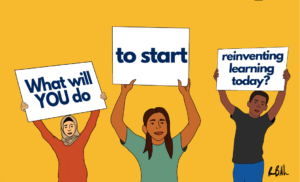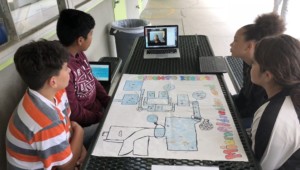A Collaborator Gets His Wings

Suburban kids are likely more able to buy computers for themselves, or have their legal guardians buy them for them. But what about minority kids and low-income students?
An African-American student called me out of the blue yesterday asking if he could link to my articles in his research paper. By all means. He’s a student at the online college Capella University. He and I got to talking about digital education and equity and we both had a very similar conclusion. America needs to be giving more minority and low-income students the technology tools they need, not so that they can just surf the web, but so that they can contribute together on the same playing field as those who possess a broadband connection and a laptop.
Clay Shirky makes a good point about social television, but what he should be focusing on is social learning. If we spent five years of our lives tethered to the boob tube, but we are asking students to power down as they walk into the classroom, aren’t we basically shooting our economy in the feet?
Here’s the maxim: Every time a consumer buys a computer, a social collaborator gets his wings.
Shirky: That’s what’s happening. Television was a solitary activity that crowded out other forms of social connection. But the very nature of these new technologies fosters social connection—creating, contributing, sharing. When someone buys a TV, the number of consumers goes up by one, but the number of producers stays the same. When someone buys a computer or mobile phone, the number of consumers and producers both increase by one. This lets ordinary citizens, who’ve previously been locked out, pool their free time for activities they like and care about. So instead of that free time seeping away in front of the television set, the cognitive surplus is going to be poured into everything from goofy enterprises like lolcats, where people stick captions on cat photos, to serious political activities like Ushahidi.com, where people report human rights abuses.
So, the Capella University student. He said he got turned onto edReformer because a student in his online class kept bringing up all this theory and bright ideas about technology and education. He said, “Who is this girl?” And when they finally talked, she let him in on the secret.
His conclusion? All that’s missing for low-income students is a school day and a learning period that is tapped into the internet. These kids are part of a community, but that community is isolated from the overall mainstream. What’s frustrating, he said (and I am paraphrasing), is that the mainstream refuses to recognize that the same tools in the hands of different cultures will round out the community as a whole and bring new ideas that foster community growth, economic growth, innovation in education and, most of all, equity in practice. Not in theory.
There are people trying to make this happen. At edReformer, for example, one of the things we believe is that a learning day shaped by technology with real teachers in the classroom means individualized attention for each student, regardless of their abilities. That individualized tech-enhanced education has been proven to be highly correlated to better standardized test performance.
As long as standardized test performance remains a marker of achievement, so be it. We can do that. But look at what is completely obvious in everyday life. The more information you have access to, the more ideas you get. The more ideas you get, the more you want to talk to people with the same ideas.
Education, by it’s very nature, is viral. It gives you wings. You can go anywhere with it. It’s time to open up the hangar doors.





0 Comments
Leave a Comment
Your email address will not be published. All fields are required.